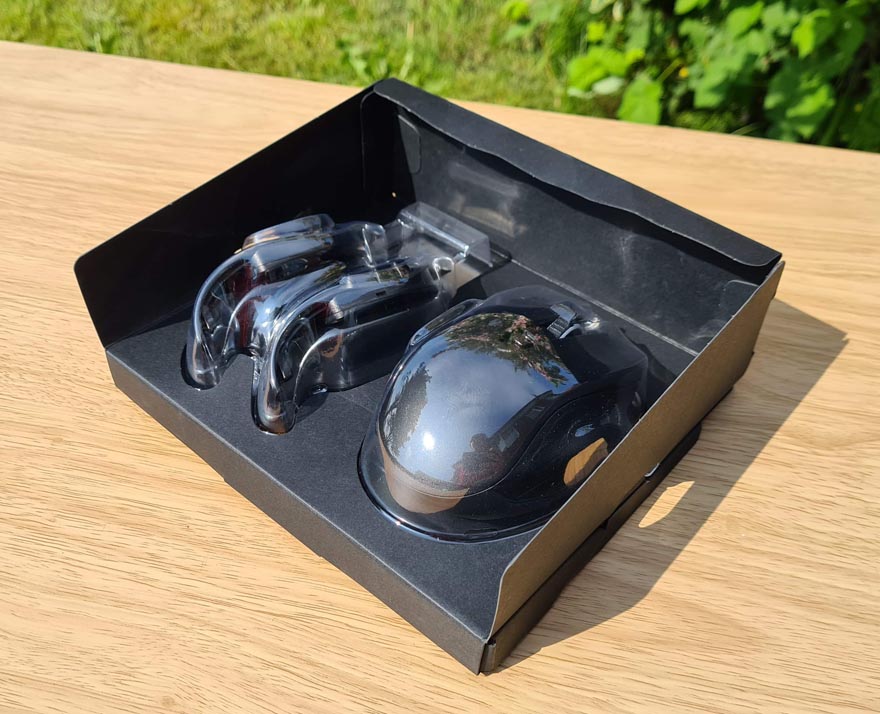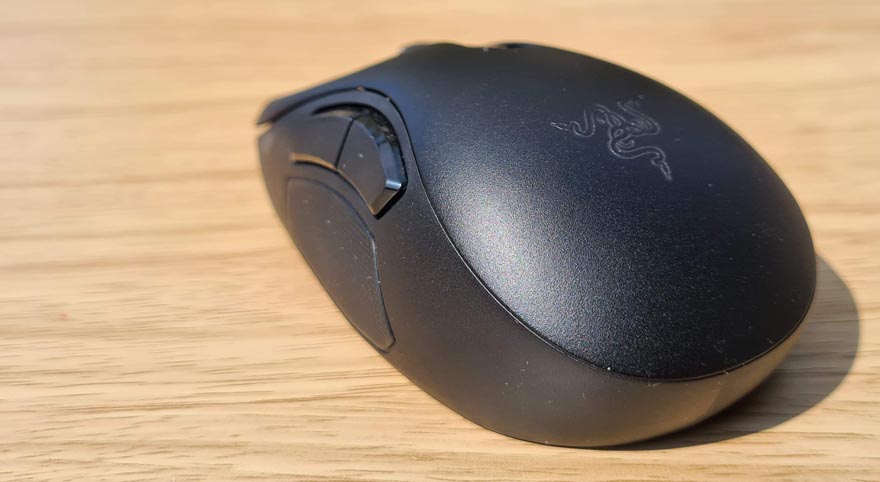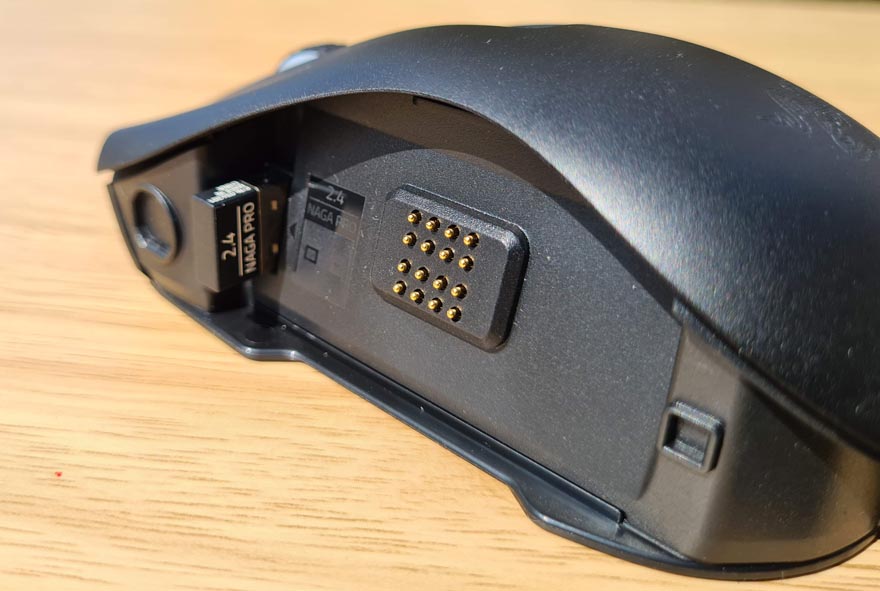Razer NAGA Pro Modular Wireless Gaming Mouse Review
Peter Donnell / 4 years ago

Razer is one of the biggest names in the world when it comes to high-end gaming mice. The new Razer NAGA Pro Modular Wireless Gaming Mouse launch looks set to continue that trend. Of course, I’ve been testing Razer mice for as long as I can remember here at eTeknix. Almost 9 years ago, I had the Naga Hex and the Naga Molten in my MMO Gaming Mouse Roundup. That’s right, I’ve been doing this for quite some time now! However, even then, the Naga mouse is actually a little more than 10 years old now. So, is there really any life left in this old dog? Can Razer refresh it enough to bring it up to speed for another decade? Well, let’s find out.
Razer NAGA Pro Modular Wireless Gaming Mouse
Razer has gone all-out on the hardware for this mouse. First, it’s fully wireless, using their latest HyperSpeed technology for ultra-low-latency gaming and an impressive 100 hours battery life. Next, there are a staggering 20 programmable buttons, so all the /emotes you can muster in any MMO game should be on tap when you need them. Next, there’s the class-leading Razer Focus+ 20K DPI Optical Sensor, offering a suite of technologies to improve accuracy. Then you have the latest Razer Optical Mouse Switches, which are some of the best switches out there. The list goes on and on. However, it’s the fully modular side panel that really stands out, with three swappable panels allowing you to choose from a 2, 6, or even a 12-button side panel layout in seconds.
Features
- 3 swappable side plates: With 2, 6 and 12-button layouts that can be easily snapped on to meet all your gameplay needs, each button provides tactile, audible feedback to make every actuation satisfying.
- Razer HyperSpeed Wireless: With extremely low latency, seamless frequency hopping, and up to 100 hours of battery life, the Razer Naga Pro has a connection so fast and smooth, you’d be forgiven for thinking it was wired.
- Up to 20 programmable buttons: Whether you’re mapping out the essentials or going all out with advanced macros, have all the commands you need at your fingertips and enjoy a degree of control that’s tailor-made for any situation.
- Razer Focus+ 20K DPI Optical Sensor: Using new intelligent functions such as motion sync and asymmetric cut-off, our sensor flawlessly tracks your movement with zero spinouts, allowing for crisp response and pixel-precise accuracy.
- Razer Optical Mouse Switch: Every click is actuated at 0.2ms with no debounce delay to give you quick, clean execution for up to 70 million clicks—a faster, more durable design that eliminates unintended double-clicking issues.
For more information, you can check out the official Razer NAGA Pro Wireless product page here.
Packaging & Accessories
The box is classic Razer, and black/green are the order of the day, but there’s also a lovely photo of the mouse on the front. Of course, it also shows the modular side panels, which is great!

Around the back, we can see it has Razer HyperSpeed Wireless, Focus+ sensor, and Optical Switches, really ticking all the boxes there. It also tells us that the mouse can be used in Wireless, USB wired or Bluetooth modes, so you’ve always got a backup connection option.

The mouse, as well as the modular side panels, are all neatly packaged in folded card, with a durable plastic shell over them.

In the box, you’ll find a USB cable, as well as a dongle dock. The actually USB dongle its self it hidden in the mouse, so we’ll see that later.

The cable is nicely braided, and comes with the custom hints of green at the headers.

The braiding is a very high quality, not that I would have expected anything less.

A Closer Look & Performance
This is one of Razer’s flagship gaming mice, and its price certainly reflects that. Of course, that means I’m going in with very high expectations of quality, and thankfully, first impressions are very very good indeed. The mouse is fairly heavy, it comes in at 117g, but the weight and build quality feel superb in my hand. The mouse is very well balanced, with near-perfect weight distribution front to back and side to side.

The shape is fantastic too, it’s fatter than a lot of gaming mice, but it just feels right. It’s tuned for longer gaming hours, so you’ll get a full-hand grip. However, what’s interesting is that in 2-button mode, you get a much larger set of side buttons and a huge rubber grip, which really helps you use the mouse in a lazy palm rest, or a more nimble fingertip grip; perfect for a bit of Halo, CS:GO, or if you’re an old-school cat like me, Quake3Arena.

The mouse has a nice shape though, it’s a bit taller and rounder than some gaming mice, but it’s a shape that’s worked well for Razer before. For me, the back of the mouse locks into the palm of my hand nicely, so I’m happy enough.

Down the right side, there’s a ridge where you can rest your ring finger, but also a small wing/grip section where you can place your little finger, allowing you to comfortably and confidently grip the mouse.

You can really see how the right side sweeps and curves to accommodate your fingers. However, the LMB and RMB are no exception, with a scooped design that naturally puts your fingers right in the optical position on the switch and generally lets your hand relax while maintaining good ergonomics.

Having used them on other gaming mice, I know the Razer Optical switches are fantastic. The LMB and RMB are both formed from the same piece of plastic that makes up the top panel of the mouse. However, they’re very long, separated by quite almost 3-inches thanks to the centre section. That means you don’t feel any crosstalk from one click to the other. They’re mounted perfectly too, with no pre or post-travel, just the action of the underlying switch.

A pair of switches up top can be used for anything from DPI/Profile adjustments to custom macros. The whole mouse is fully programmable, allowing to put some serious customisation into each games profile. The mouse wheel is nice and large and has a really responsive click of its own. However, it also allows for left/right nudging, adding more buttons to the mouse; you can disable that if you don’t want it, though.

Despite being a heavier mouse, it moves very easily thanks to the four large pads on the bottom, and there’s an additional one around the sensor too. So while an FPS eSports pro may want an ultra-light mouse, the weight and balance here lend well to smooth and accurate movements even at higher DPI levels.

There are two pins on the bottom of the mouse, too, meaning it’s compatible with the optional Razer Mouse Dock Chroma stand. There’s a switch here for turning the mouse off and switching between 2.4 GHz wireless and Bluetooth modes. There’s also a profile button down here too, which is always handy!

There are three modular panels on this mouse. Of course, one of them comes pre-installed, but the other two are included in the box.

The 12 button panel looks absolutely fantastic and actually makes me think of my own MMO gaming mouse, the Corsair Scimitar, which also has 12 buttons on the side. Albeit the Corsair solution ONLY has 12 buttons, you can’t change it to 6 or 2 buttons.

The panel uses a pin free design, with a bunch of contacts on the back and two strong magnets to mount it. No tools, no software adjustments required, you pull off one panel, and the new ones snap into place.

The next one is the 6-button design, which has larger buttons than the 12-button, making good use of the space. They’re more pronounced too, which I think makes them easier to index without looking. I love that they haven’t compromised the feel of any of the panels either. Every button has a gorgeous little click from their own microswitches; no mushy membrane stuff going on here!

The mouse has a 16 pin panel and those two magnetic docks. So it really is plug and play, and anyone can quickly swap out as they see fit.

Also tucked under the panel is a USB dock, allowing you to store the wireless dongle. It’s a great design, as it’ll make it extremely hard to lose the dongle.

Just pull it out, and you’re ready to go. One thing I do love is that the mouse pairs, as best I can tell, instantly. From first use, I flicked the switch to 2.4 Ghz mode, and there was no delay in being able to move the cursor. Under Windows 10, the mouse was detected straight away, and I was also prompted to download Razer’s software. Normally, I don’t care for it, but with so many buttons to configure, it’s certainly recommended here if you want to enjoy the true value of this mouse.

I love the 12 button and the 2-button panels, but I can certainly appreciate having the 6-button in here too. Razer suggests games like Guild Wars 2 for the 12-button, but myself, I found it worked great for Elder Scrolls Online, having a few attacks and abilities on there, as well as some inventory macros and emotes that I like to have to hand.
The 6-button is great for Battle Royale/MOBA games, which I don’t really play anymore, but the Fortnite, Apex Legends, and DOTA 2 fans out there will greatly benefit from this. The 2-button is just straight up ready for FPS gaming. Simplified, easy to use, and great for everything from CS:GO to Halo MCC.

Whatever button configuration you want, that’s up to you. However, that 20K DPI sensor is as good as they come. It passed my little mouse gauntlet with flying colours, showing no signs of prediction, angle-snapping, acceleration, etc., throughout a wide range of DPI settings. Any flaws in the smoothness here were certainly my own, which is actually what I want to see in this test; perfectly imperfect.

Interesting, the 12-button panel is LED lit and syncs with the RGB of the mouse. However, that’s not true of the 6-button or the 2-button panel. Perhaps it’s because you need to look at this panel a little more, while the 2-button is simple, and the 6-button has larger and easier to index buttons.

As you might expect, the RGB is excellent, and can all be configured through the Razer software. Of course, if you leave it at default, it’s just a slow colour cycle, which looks great. However, you can tinker with every LED for every profile if you really want to procrastinate your day away.

The mouse is really fantastic however you configure it though. It’s surprising how easy it is to switch between side panels, and how fast my fingers adjust. However, I do swap mice regularly due to my work, so that may have some influence. It also looks amazing, it’s a very cool looking mouse, and it wants to be, given the premium price tag.

Overall, I think Razer has absolutely nailed it (again).

How Much Does it Cost?
The Razer NAGA Pro Modular Wireless Gaming Mouse is available right now from the usual retailers. Of course, this is a very high-end mouse, with a lot of premium features. The price certainly reflects this too, with an MSRP of £149.99, it’s clearly not going to be an impulse purchase. However, It’s currently just £125.54 on Amazon, which is a bit easier to swallow. However, if you want it with the Mouse Dock, which I admit, I do, it’ll be £196.79. However, if you want a similar modular design, the Razer NAGA Trinity is only £69.99, but overall, it’s wired and uses older technologies throughout its design.
Overview
The price of this mouse is pretty high, I will admit, but I still think it represents very good value for money. No, seriously, I really do. Let me explain! A 12 button MMO gaming mouse is anything from £70-90 for the Corsair Scimitar Elite RGB or the Logitech G600. However, they’re not wireless gaming mice, which certainly adds to the value. Furthermore, it’s a high-end wireless with lower latency, so more comparable with the new flagships from Corsair and SteelSeries, which are again more expensive.
Then we get onto the sensor, and it’s fair to say that Razer has most gaming mice absolutely whipped here too. The Razer Focus+ Optical Sensor has a blisteringly high-end 20,000 DPI true tracking speed. Razer claims that it’ll do 99.6% resolution accuracy, which is to say, it’s fantastic. It’s also far above what we would normally see on a wireless mouse, as it’ll be a little power-hungry. However, I suspect the slightly heavier design of this mouse is for a bigger battery to compensate for this; around 80-100 hours wireless or even 150 hours in Bluetooth with the lights off.
They’ve equipped it with the Razer Optical Mouse Switches too. These use an infrared beam to register the click, rather than a copper contact. Giving them a 0.2 milliseconds response time, with no debounce delay, making them sharp enough to spark interest in the eSports scene.
Then you’ve got the multiple points of connectivity. Fully wireless using the USB dongle and 2.4 GHz technology, which, as far as I can tell, is just as responsive as the mouse is in wired mode. It doesn’t compromise on performance at all. And, as I just said, you can use it as a fully wired USB mouse too, which is also a way of keeping it charged, so you never have to stop playing. Finally, Bluetooth mode means it’ll pair directly with a mobile device, laptop or similar too.
The list keeps going on because there are no mice on the market with the same level of hardware, and also that offer three fully realised button layouts. There are other modular mice out there, but again, nothing with a sensor, battery life and switches that come close to matching the Naga Pro. Being able to switch between a 2-button FPS mouse, a 6-button MOBA mouse, or a 12-button MMO mouse means that you always have the best tool for the job.
Should I Buy One?
The value of this mouse can be found in every single aspect. It has a class-leading sensor, switches, and battery performance. You get multiple connectivity options too, so you can always play no matter what/where. However, the fully modular side panel means you’re getting three styles of gaming mouse in one package, making this exceptional value for money. It’s not cheap, but for a flagship wireless gaming mouse with this many features, it’s currently the most versatile and advanced mouse I’ve ever used. Highly recommended!



















